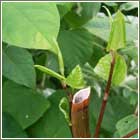(Polygonum spp.[Polygonum cuspidatum, sachlinese & polystachyum])
 Stem/Leaves: The stems can
grow up to 10 ft. tall. The leaves are broadly oval to
somewhat triangular with a texture similar to satin. The stems
are usually angled at each node. (2)
Stem/Leaves: The stems can
grow up to 10 ft. tall. The leaves are broadly oval to
somewhat triangular with a texture similar to satin. The stems
are usually angled at each node. (2)Flower: The flowers are small and can be a creamy white to to a green/white. They grow in a plum like patterns in branched clusters from leaf axles near the end of the stems. (2)
Probable Entry: It was introduced to many areas, including Montana, as an ornamental. Part of the reason it spreads so quickly is due to the fact that it was very popular as an ornamental for a while. (2)
Seeds: It has tiny seeds which are hidden inside husks embedded in paper like sheaths. (3) (2)
Spread: This plant spreads by long rhizomes (under ground stems) that can survive the toughest of conditions, as well as spreading through plant cuttings and seeds. (1)
Infestation: This plant can grow almost anywhere in Montana. It can tolerate tough conditions such as high temperatures, high salinity, drought, and floods. (3)
Control Agents:
Biological Control: There are currently no legal biological agents in the U.S. Some are under consideration especially in the U.K. (2)
Cultural Control: Grazing and cutting will help to control the knotweed, but will not totally eradicate it. (2)
Chemical Control: This is the most effect form of control. Japanese knotweed will often need repeated treatments before dying completely. Some effective herbicides are glyphosate and 2, 4-D amine. (2)
Links:
1. http://en.wikipedia.org/wiki/Japanese_knapweed
2. http://www.invasivesspeciesinfo.gov/plants/knotweed.shtml
3. http://www.nps.gov/plants/alien/fact/pocu1.htm
4. http://www.cabi-bioscience.org/html/japanese_knotweed_alliance.htm
5. http://www.ecy.wa.gov/programs/wq/plants/weeds/aqua015.html
6. http://www.invasive.org/browse/subject.cfm?sub=3414
7. http://landscaping.about.com/cs/weedsdiseases/a/knotweed.htm
8. http://tncweeds.ucdavis.edu/moredocs/polspp01.pdf
9. http://www.nwcb.wa.gov/weed_info/written_findings/polygonum_cuspidatum.html
10. http://www.fs.fed.us/r10/spf/fhp/leaflets/Japanese_knotweed.htm
Works Cited:
1. CABI Bioscience and the Japanese Knotweed Alliance. "Japanese Knotweed". Japanese Knotweed Alliance. 2007. CABI. February 16, 2008.
http://www.cabi-bioscience.org/html/japanese_knotweed_alliance.htm
2. Remaley, Tom. "Least Wanted". Japanese Knotweed. May 16, 2007. Plant Conservation Alliance. February 17, 2008.
http://www.nps.gov/plants/alien/fact/pocu1.htm
3. No author. "Invasive Species". Japanese Knotweed. October 15, 2007. Invasive.org. February 15, 2008.
http://www.invasive.org/browse/subject.cfm?sub=3414
By: Helen H. and Marina S. 3/2008. Back to Weed ID
mtwow.org HOME